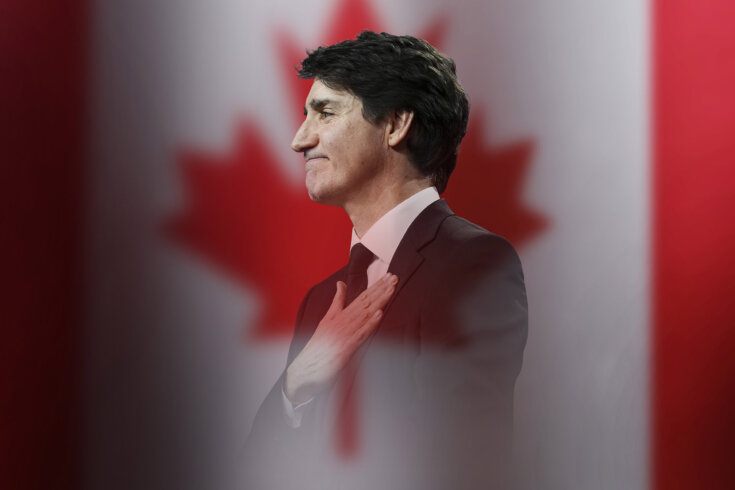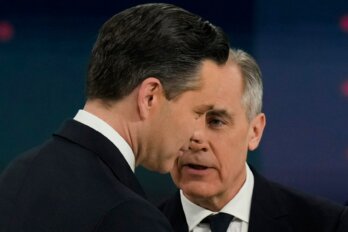T he morning after leading the Liberal Party to a stunning come-from-behind majority in 2015, Justin Trudeau, prime minister–in–waiting, showed up at a Montreal Metro station. He was there to greet surprised commuters and, in many cases, share his gratitude for the victory. A cynic might have dismissed it as staged, an act befitting a former drama teacher.
But as Chris Turner wrote days later for The Walrus, such scorn was exactly why Liberals won—or at least why their opponents lost. They refused to believe that what you saw with Trudeau was what you got. Canadians, on the other hand, were more willing to take him at his word. Sunny ways, eh? Okay, if you say so. And they gave him, and his party, plenty of leeway to prove it. “You have our support, Justin Trudeau,” Turner wrote. “Don’t squander it.”
Let’s not kid ourselves. The metro visit also strategically underscored the message that things had changed. No more Stephen Harper, yes, but also no more Harper style. Here was Justin, happy to hang with the hoi polloi. Harper never had these retail political skills. He was seen as cold and calculating, famously mocked for shaking hands with his son at a school drop-off.
For Trudeau and his team, however, the human touch was often part of the performance—not as a gimmick but because it spoke best to his affinities. “Never underestimate the power of symbols in today’s world,” Trudeau said as he trained three years earlier for his boxing match against then Conservative senator Patrick Brazeau—a fight he won.
A few hours after the metro glad-handing, at a rally in Ottawa, Trudeau told the crowd, “On behalf of 35 million Canadians, we’re back.” It was another mark of the new direction he aimed to chart: a politics built on raising expectations, mixed with a gift for storytelling. The quip made headlines around the world, followed in the weeks afterward by buzzy stories about Trudeau’s forward-looking vision, summed up in his crisp one-liner about his gender-balanced cabinet—“because it’s 2015.” There was also a splashy Vogue cover and lots of chatter about his socks.
Over the next decade, one theme held throughout Trudeau’s career as prime minister: he was a very good campaigner, even when he wasn’t campaigning—or perhaps especially in those cases. Looking back, it seems fair to say Trudeau’s time in power is a study in the perils of the symbolism he understood so well, maybe to a fault. The gap between message and delivery started to widen. His leadership rested on his ability to project hopeful idealism. But his honestly held beliefs in empathy and inclusion—beliefs that resonated with Canadians in 2015, beliefs that would carry him through major crises—eventually hit a limit.
In the end, Trudeau gravitated toward big problems the way he did grand gestures. He was drawn to the scale, the spectacle, and the promise of transformative change. But communicating the finer points of policy never came easy, and after ten years, it got a lot harder.
T he carbon tax is a good example. A cornerstone policy from Trudeau’s early days that spoke to a big idea: stop climate change. It was immediately scrapped by his successor, Mark Carney. During the 2015 campaign, Angus Reid Institute found that 56 percent of Canadians supported a carbon tax—in theory. A few months after the Trudeau Liberals’ 2015 election victory, Abacus Data found that Canadians largely believed in human-influenced global warming and that Canada should do more to reduce emissions. But already by 2017, Canadians were souring on the idea. That July, the Angus Reid Institute reported that just 44 percent of Canadians said they supported a national carbon tax.
The tax, when implemented, could have been effectively sold as a benefit to lower-income Canadians, who would receive more via a rebate than they would pay in additional costs, but it never landed that way. By 2024, many people who received the rebate didn’t even know what it was. That might have been because of the new, stricter government advertising rules the Liberals put in place. But it also highlighted a tendency with the Trudeau Liberals to trust that everyone saw the logic of things the same way they did. Why question the details when the big picture was being addressed? Here was a problem that needed to be solved, here was a solution—what part of that didn’t make sense?
You could call this approach patronizing, and in a few cases, it felt like that. But it wouldn’t be the first time, nor the last, that a government or prime minister has failed to read the room. And if we want to be fair, for the first few years after his majority, the national mood generally matched Trudeau’s. But within a few years, that started to change. “What you see is what you get” works only when what you see is what you want. Otherwise, as Trudeau learned, you start to lose people.
In fact, Trudeau may have started to lose support earlier than many expected, at least online. Shortly after the Liberals formed government, Facebook reworked its algorithm to prioritize high-engagement content, which often meant sensational, emotionally charged, or misleading posts. This change flooded users’ feeds with misinformation and negativity, deepening skepticism toward political figures and contributing to a more polarized and hostile digital environment. It’s impossible to draw a straight line from that digital shift to Trudeau’s waning appeal, but it may have helped cultivate a more skeptical atmosphere around him.
That skepticism only deepened as the broader political landscape grew more volatile. In 2016, the first seismic shock of the Trudeau era hit: the Brexit–Trump double tap to the post–Cold War world order. The tenor of the discourse changed. Rather than recalibrate in response, Trudeau and his team seemed to double down, casting the government as a bulwark against the new climate. They leaned harder into the values Trudeau had campaigned on—pluralism, social justice, and democratic norms—even as the mood around them grew more cynical.
Two reasons for this tactic seem likely. First is that Trudeau and his team believed in their stated convictions and the need to defend them. Second, it created a contrast, both between Trudeau and Trump and between Trudeau and the Conservatives, reassuring liberal Canadian voters of their choice to keep them onside. I would guess that it also likely helped with fundraising. With the per-vote subsidy eliminated, Canada’s political parties have grown more dependent on donations. Increasingly, those dollars are raised online—where, as Facebook had already discovered, nothing drives engagement quite like fear and outrage.
Speaking of democracy, it was around this time that Trudeau walked back on his promise about electoral reform. On its own, the reversal might have only irritated the political diehards and policy wonks. But it became the first in a string of first-term missteps that would dog him for years: the SNC-Lavalin affair, in which he was accused of pressuring his attorney general to intervene in a criminal case; the widely mocked trip to India, complete with both sartorial and diplomatic blunders; and the ethics breach over a personal vacation to the Aga Khan’s private island.
Then, as he sought re-election in 2019, his blackface and brownface photos surfaced. They severely undercut his credibility as a defender of diversity and cultural sensitivity—values he had openly espoused and that the millennial set, who backed him heavily in 2015, still largely believed in.
All of it spoke to the worst aspects of Trudeau’s image that he’d fought to reverse since his first campaign: entitled, dismissive, childish. Not ready.
E ven still, Trudeau’s popularity remained reasonably high, especially when it came to comparing him to Donald Trump. Then, the COVID-19 pandemic gave him a fresh chance at reclaiming his former 2015 glory. The domestic scandals suddenly looked much less important in the context of lockdowns. When Trudeau took to his Rideau Cottage dais, his natural inclination for empathy positioned him well as a national guide. He got to be a symbol for Canada’s resilience and kindness. He got to be a fighter again. The underdog.
And whereas the Liberal government’s tendency to defer to consultations may have hampered them in other policy areas, the approach worked during the pandemic. Trudeau’s ministers conferred with premiers. There was even coordinated messaging, specifically that things would “get back to normal.” But comforting as it may have been at the time, that message, alongside major spending on pandemic recovery programs, like the Canada Emergency Response Benefit and the Canada Emergency Business Account, would come to define Trudeau’s later years in ways that were unexpected.
The truth was that things were not going to return to normal. But while everyone waited to see if they would, other aspects of life became too abnormal for a lot of Canadians to stand. The lockdowns were one thing. Masks another. And the vaccines, which Trudeau promoted heavily, and rightly, became a rallying point for a new kind of conspiratorial, insular, and angry body politic. This mood increasingly came to see Trudeau’s daily speeches as proof of his consolidation of power (much of which he did not, in fact, possess—mask mandates and lockdowns were, after all, imposed by provincial and territorial governments).
As for the CERB and CEBA, they cost the government in more ways than one. The spending was necessarily huge and held the inherent risk of inflation, which inevitably came. But nobody could have expected how bad it would be—least of all, it seemed, Trudeau.
The election in 2021, held amid the pandemic, was framed both by the official opposition and by many of those who simply opposed Trudeau, as being opportunistic. Maybe so. Governments often are when they are trying to shore up their power. Still, it marked a turning point in Trudeau’s rhetoric and, when it came to his aggressive defence of vaccines as a wedge issue against the Conservatives, appeared to deepen his conviction, pushing it toward righteousness.
And to be clear, Trudeau was right to defend the vaccine policy. After all, it worked. But by 2022, Trudeau’s new rival, Pierre Poilievre, came on the scene. And Poilievre didn’t find his form in the same internet that elevated Trudeau in 2015—a space buoyed by optimism and connection. Instead, he drew on the darker, more polarized online world of the 2020s. He understood, intuitively, how to weaponize grievance, how to translate Trudeau’s policies and his often high-handed and hectoring tone into a narrative of elite contempt for ordinary people. Trudeau didn’t want to hear from Canadians, Poilievre alleged. Trudeau wanted to attack the truckers’ freedom. He limited our access to independent media. He would make us eat bugs. And so on.
Trudeau was also, Poilievre said, making life more expensive. This wasn’t wholly accurate, but it was true enough, as far as political rhetoric goes. The pandemic’s supply and labour shortages made things bad, and Russia’s unexpected invasion of Ukraine made things much worse. In reality, Trudeau’s government had worked to make life more affordable for Canadians. There was a tax cut for the middle class. There was $10-a-day daycare proposal. And there was the Canada Child Benefit, one of the most successful policies in decades, credited with reducing child poverty.
But like it did everywhere, in Canada, too, the pandemic exacerbated issues that already existed, most of all inequality. The pandemic also affected our trust in institutions. Trudeau was a victim of both trends, fairly or unfairly. He appeared to have little immediate relief to offer for people’s pocketbooks. His government did not prioritize the cost of living to the degree that was necessary by that point—and they now struggled even more to credibly argue for the policies they had implemented. Then there’s the simple fact that, during his decade as prime minister, the price of services crept up and up. Food, insurance, cellphone contracts, subscription services—all of these costs were higher by the time the pandemic was over.
Then there was immigration. There’s a poetic injustice in the fact that Trudeau, welcomed to office on the rhetoric that Canada is stronger because of its differences, and who successfully threw open the doors to more than 44,000 Syrian refugees, must list immigration as the file that sunk him in the polls. The Liberal government’s decision in 2022 to expand Canada’s intake of new permanent residents to 500,000 by 2025 seemed a rational response to the pandemic-induced labour shortage. But it was another move that was treated as self-evidently sensible and was therefore more or less exempt from explanation.
But as far as many Canadians were concerned, all it did was make housing less available and affordable, especially in the vote-rich areas of British Columbia and Ontario (the latter of which contributed heavily to the problem, with an abysmal record of housing starts over the past decade). Even Trudeau conceded in a 2023 CBC interview, at which point it was painfully obvious, that he could have acted sooner on the issue.
But the twin issues of immigration and housing were the last straw for Canadians—and the final ingredient for Poilievre’s nativist-change narrative. Trudeau was finally down for the count.
W e all know what happened next. Trudeau wasn’t out. Trump’s second administration began on the heels of Trudeau’s announcement that he would step down. As he did, he likely banked on his pending departure eliminating him as a topic of conversation for the anti-Trudeau extremists who’ve been the energizing force behind the Poilievre Conservatives.
But Trump never let us find out if that was true. Instead, he gave Trudeau a parting gift. He made Trudeau the underdog again. With that, in his final days as prime minister, Trudeau was able to recapture some of that 2015 spirit. His responses to the tariff threats were bold, tough, and, above all, honest. In a word, Canadian. It was a reminder of why this eager, proud, and overall decent guy won in the first place. Why people wanted him in their corner.
On his penultimate day as prime minister, Trudeau went back to the Montreal Metro. Again, he met with constituents. Again, there was a camera present. Trudeau, after all, understands the power of a symbol. But it’s also hard to believe that there’s anyone left in Canada who could think it was a phony act. Trudeau truly believed that an appeal to the better angels of our nature could help to create a better Canada. Is he wrong?
Still, what also seems true is that, in practice, Trudeau’s adherence to those ideals and the strength of his convictions—most importantly, the belief that they would speak for themselves—made him look aloof, even arrogant. Indeed, he was often too dismissive of dissent, both internal and external, and frequently assumed that the logic of his vision was obvious.
But beneath these contradictions was sincerity. Trudeau believed in himself, his message, and in his country. What you saw, for better or worse, was what you got.





